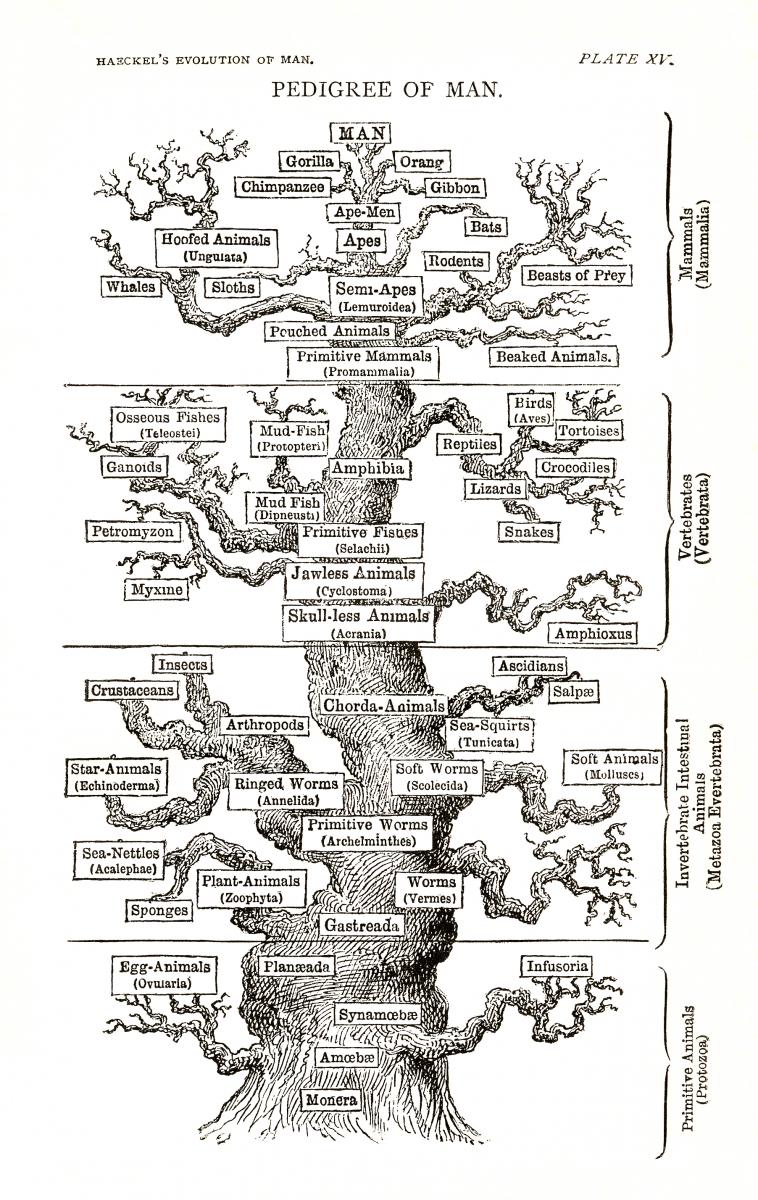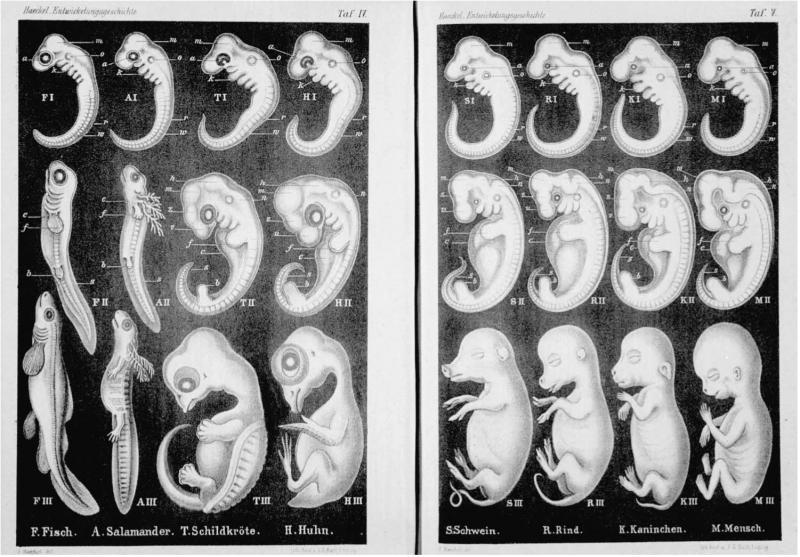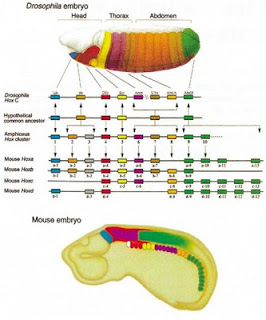Next up on our tour of misunderstood and/or maligned evolution-related topics—embryos!
I’d wager that if I asked you to draw an early-stage embryo of a human, fish, or chicken, you’d probably draw the same thing: A kind of C-shaped squiggly tube with an eye at one end. And I’d wager that for most of you, the image formed in your head of these embryos stems from a diagram you’ve seen in a biology textbook or on the web that shows different early-stage embryos lined up to best illustrate their stunning similarities. I’d also wager that if I asked you what you know about Haeckel, you’d mention two things: embryos and “he was a fake.” So, what’s the story?
First, it’s important to know that Haeckel was not the first to compare developing organisms. In the early 1800s, scientists began looking at embryos through newfangled microscopes and were quick to notice similarities across the board. The early embryos of animals as different as chickens and fish had similar vessel branching patterns and slits in their necks, for example. As fish developed, these vessels aligned with gill slits. As chickens developed, the slits closed up and the vessels rearranged and became associated with lungs.

In these pre-Darwinian days, scientists were very prone to a ladder-of-life thinking, the scala naturae, with lowly invertebrates at the bottom and humans at the top. So, looking at the embryos, these scientists developed a theory of developmental recapitulation. Chickens sit on a higher rung than fish, so perhaps as they develop, chickens recapitulate the forms on lower rungs. In other words, on its way to becoming a chicken, the chicken embryo passes through a phase of being a fish.
Karl Ernst von Baer, in 1828, refuted this idea by showing that when embryonic stages are closely examined, they simply do not pass through such hierarchical stages. Chicken wings do not first develop into fins. And human arms do not at any stage develop into wings. Rather, von Baer noted, chicken and human limbs (and those of other tetrapods) start off as similar buds and then differentiate in later stages.
Darwin cited von Baer’s work as evidence of this theory of common descent. It made sense to Darwin that chicken and human limbs start off similarly because chickens and humans share a relatively recent common tetrapod ancestor (where “relatively recent” means about 300 million years ago). Further, it made sense to him that there were some more general similarities among ray-finned fish, chickens, and humans because they, too, shared a common ancestor, albeit one a bit further back in time (about 400 million years ago) than the one shared by just chickens and humans.
Enter Haeckel. When On the Origin of Species came out in 1859, Haeckel read it eagerly. At the time, he was a professor of comparative anatomy at the University of Jena with a keen interest in embryology. Haeckel was a quick adopter of Darwin’s hypotheses, but he did not shed his scala naturae way of thinking. He thought that new life forms were produced when novel innovations were layered upon pre-existing ones. He expanded upon the recapitulation idea of development and coined the phrase “ontogeny recapitulates phylogeny”—in other words, the stages of an organism’s development (ontogeny) recorded its evolutionary history (phylogeny). Thus a human embryo passed through the more-or-less adult forms of organisms lower in the evolutionary ladder, from an amoeba on up.

Thanks to the catchy catchphrase and Haeckel’s talent for self-promotion, the so-called Biogenic Law did become quite popular, though it was not adopted by many scientists—other embryologists had already disproven the idea of recapitulation, after all. His book Generelle Morphologie den Organismen was published in two volumes in 1866 and did not sell very well. So why is he such a pariah? Who cares! So he had a bad idea, no big deal, right? Well, the problem wasn’t so much that he had a bad idea, but that he fudged some drawings when adapting his work for a non-scientific audience, first in Natürliche Schöpfungsgeschichte (1868), then in Anthropogenie (1874). What did he do? Well, he used the same woodcut for the early stage embryos of the dog, chicken, and turtle, for one, and then he did a little creative editing in some other drawings, enlarging here, erasing some limb buds there…think of it as pre-Photoshop photoshopping.
Haeckel was caught in his own day, however, and conceded that he had made the changes. His defense was that a certain amount of didactic license was allowed in a work of popular science. But of course, the story doesn’t end there. A century or so later, Haeckel’s drawings (or, often, redrawings by George John Romanes) were still used to illustrate developmental evidence for common descent and, looking for bones to pick, creationists declared that evolution was therefore wrong because it relied on bad science. Textbooks carrying embryonic images were criticized and lobbied against. (When a textbook I worked on was reviewed in a particular state, we got a comment criticizng our inclusion of “faked embryo drawings.” In fact, we didn’t include any such thing. Instead, we had photographs of actual embryos. We guessed that this particular reviewer just copied and pasted his talking points without ever opening the book.)
Okay, so perhaps Haeckel altered a few illustrations, and we know that his assertion of literal recapitulation was wrong, but we still talk about comparative embryology today. Why? Because the early similarities are indeed evidence for common descent. Darwin was right…again. Early embryos of organisms as different as a sea squirt and a human show certain similarities, called developmental homologies, because they share a common ancestor. In general, the more closely related two organisms are, the more of these homologies there will be. Thus, the developmental stages of human embryos and those of other mammals have more in common than do the developmental stages of human embryos and those of fish.

The modern synthesis of development, genetics, and evolution (“evo-devo”) has piled on results in support of common descent, as scientists have come to understand that from flies to mice, many features of adult organisms can be traced back to similar embryonic precursors, which in turn are patterned by a set of genes that are expressed in early development. Thanks to these discoveries, we now understand that what’s so important is not that the embryos of different organisms look alike, but that their development is controlled by a small set of evolutionarily conserved master control genes. If Darwin had known about Hox genes, I think he may have danced a jig of excitement.
In sum: the specifics and ethics of Haeckel in this one arena (he did a lot of other good work over his career): not so great. Embryonic similarities as evidence for common descent: no problem. So, while I don’t think I’ll be pushing NCSE to make any “Honk if you love Haeckel!” T-shirts, I might just propose one along the lines of: “Honk if you understand developmental homologies!”

